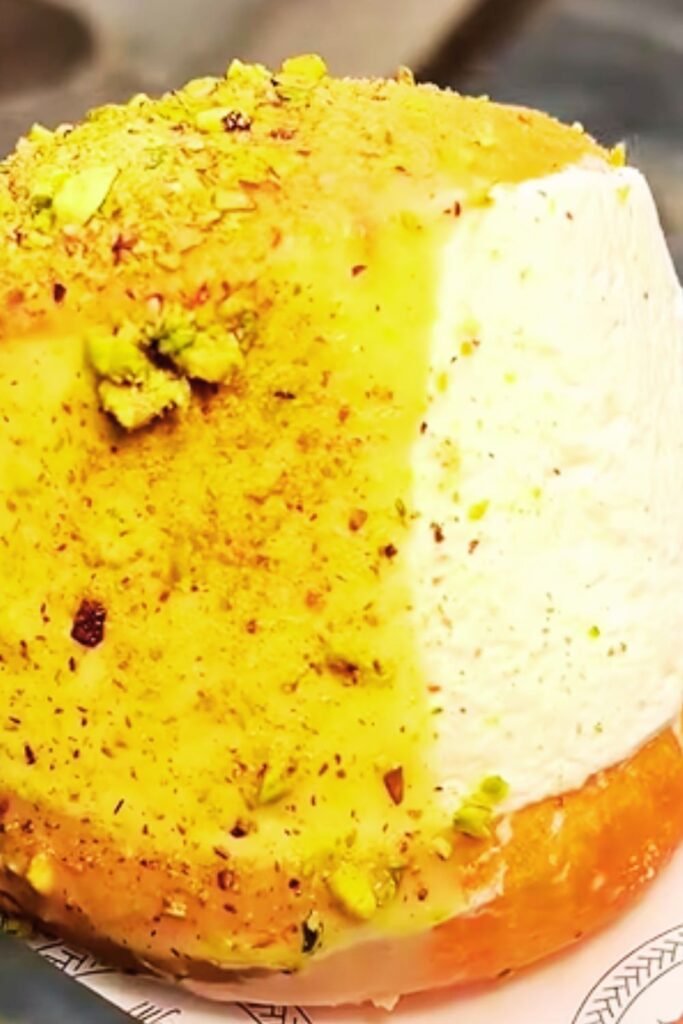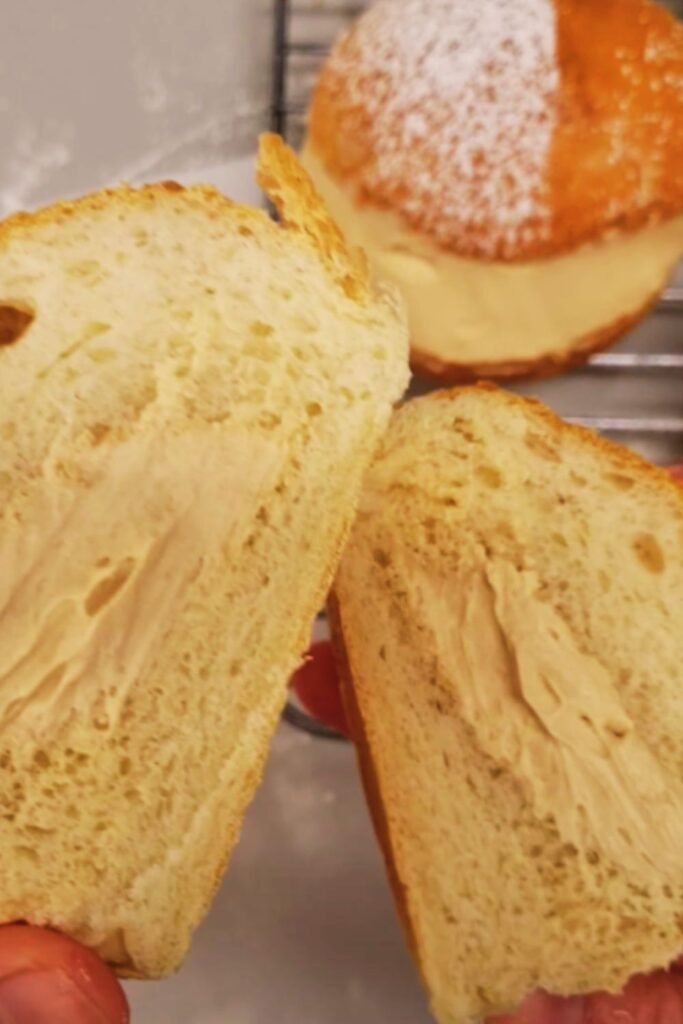When I first encountered a maritozzo in a Roman bakery, I knew I’d stumbled upon something extraordinary. This golden, pillowy-soft roll, generously stuffed with vanilla-scented whipped cream, represents the very essence of Italian comfort food. Unlike the elaborate pastries that dominate many European capitals, the maritozzo embodies Rome’s approach to sweetness—unpretentious, generous, and utterly satisfying.
The maritozzo has graced Roman breakfast tables for centuries, evolving from a simple sweetened bread into the cream-filled delight we know today. Its name derives from “marito” (husband), as these sweet rolls were traditionally given by suitors to their beloveds. Today, they remain a symbol of affection, though thankfully, anyone can enjoy them without romantic obligations.
Understanding the Maritozzo: Definition and Origins
Maritozzo: A traditional Roman sweet bread roll, typically oval-shaped and enriched with eggs, butter, and sugar, then split and filled with sweetened whipped cream.
Pane Dolce: The Italian term for sweet bread, which encompasses the maritozzo family of baked goods.
Crema Chantilly: The classic vanilla-flavored whipped cream filling, though modern variations include chocolate, pistachio, and seasonal fruit creams.
Lievito Madre: Natural sourdough starter traditionally used in authentic maritozzo preparation, contributing to the bread’s distinctive tang and texture.
The maritozzo’s history stretches back to ancient Rome, where similar sweet breads were offered at religious ceremonies. During the medieval period, Roman bakers began enriching their dough with eggs and butter, creating the foundation for today’s recipe. The cream filling didn’t appear until the 20th century, when refrigeration made it practical to store dairy-based pastries safely.
Essential Ingredients and Their Roles
Creating authentic maritozzi requires understanding how each ingredient contributes to the final product. I’ve learned through countless attempts that quality ingredients make an enormous difference in both flavor and texture.
Flour and Structure
The foundation of any great maritozzo lies in the flour selection. I recommend using tipo 00 flour for its fine texture and moderate protein content, which creates the tender crumb characteristic of these rolls. If tipo 00 isn’t available, all-purpose flour works adequately, though the texture will be slightly different.
Strong bread flour should be avoided, as it creates too much gluten development, resulting in a chewy rather than tender texture. The protein content should ideally range between 10-12% for optimal results.
Enrichment Elements
Eggs: Fresh, room-temperature eggs provide structure, richness, and the beautiful golden color. I use one whole egg plus one additional yolk for every 500g of flour.
Butter: European-style butter with higher fat content (82-84%) creates superior flavor and texture. The butter must be softened but not melted when incorporated.
Sugar: Granulated sugar feeds the yeast while adding sweetness. The amount should balance sweetness without overwhelming the bread’s subtle flavor.
Milk: Whole milk contributes to the tender crumb and helps create the characteristic golden crust.

Traditional Preparation Method
Dough Development Phase
The maritozzo dough requires careful attention to timing and temperature. I begin by dissolving active dry yeast in lukewarm milk (around 100°F/38°C) with a pinch of sugar. This step, called proofing, ensures the yeast is viable and creates a frothy mixture within 5-10 minutes.
In a large mixing bowl, I combine the flour with the remaining sugar and salt, creating a well in the center. The proofed yeast mixture goes into this well, followed by beaten eggs and softened butter. Using a wooden spoon, I gradually incorporate the flour from the edges, forming a shaggy dough.
Kneading Technique
Proper kneading develops the gluten structure necessary for the maritozzo’s characteristic texture. I turn the dough onto a lightly floured surface and knead for 10-12 minutes using the heel of my palm. The dough should become smooth, elastic, and slightly tacky but not sticky.
A properly kneaded dough passes the windowpane test—stretching a small piece thin enough to see through without tearing. This indicates sufficient gluten development for the light, airy texture maritozzi require.
First Rise
The enriched dough needs a longer rising time than basic bread due to the eggs and butter, which slow yeast activity. I place the dough in a greased bowl, cover with a damp cloth, and let it rise in a warm, draft-free location for 1.5-2 hours, or until doubled in size.
During colder months, I create a proofing environment by placing the covered bowl near (not on) a warm oven or in an oven with just the light on.
Shaping and Baking Process
Traditional Shaping Method
After the first rise, I gently deflate the dough and divide it into 8-10 equal portions, depending on desired size. Each portion gets shaped into an oval by first forming a ball, then gently rolling and stretching into an elongated shape about 4 inches long.
The shaped rolls go onto parchment-lined baking sheets, spaced at least 3 inches apart to allow for expansion. I cover them with a clean kitchen towel for the second rise, which takes 45-60 minutes.
Egg Wash Application
Before baking, I brush each maritozzo with beaten egg mixed with a tablespoon of milk. This creates the characteristic golden, glossy crust that makes these rolls so visually appealing. Some bakers add a sprinkle of pearl sugar at this stage for extra sweetness and texture.
Baking Parameters
| Parameter | Specification | Notes |
|---|---|---|
| Temperature | 375°F (190°C) | Preheat for 20 minutes |
| Baking Time | 15-18 minutes | Until golden brown |
| Internal Temperature | 190°F (88°C) | Use instant-read thermometer |
| Pan Position | Middle rack | Ensures even browning |
| Steam Method | Pan of water on bottom rack | Creates softer crust |
The maritozzi are done when they sound hollow when tapped on the bottom and have achieved a rich golden color. I let them cool completely on wire racks before filling—warm bread will melt the cream filling.

Vanilla Cream Preparation
The cream filling distinguishes mediocre maritozzi from exceptional ones. I prepare traditional vanilla-scented whipped cream, though modern variations include mascarpone-enriched versions for extra richness.
Classic Whipped Cream Method
For the filling, I use heavy cream with at least 35% fat content, which whips to stable peaks and holds its shape when piped. I chill the cream, bowl, and beaters in the refrigerator for 30 minutes before whipping—cold equipment creates better volume and stability.
Ingredient Ratios for 6 Maritozzi:
- 2 cups heavy cream
- 1/4 cup powdered sugar
- 2 teaspoons vanilla extract
- Pinch of salt
I begin whipping at medium speed until the cream begins to thicken, then increase to high speed. The key is stopping at soft peaks for filling maritozzi—overwhipped cream becomes grainy and difficult to pipe.
Flavor Variations
Vanilla Bean Cream: Scraping seeds from one vanilla bean pod creates intense flavor and appealing visual speckles.
Orange Blossom Cream: Adding 1 teaspoon orange blossom water creates a delicate floral note popular in southern Italy.
Mascarpone Cream: Folding 1/2 cup mascarpone into whipped cream creates richness reminiscent of tiramisu.
Chocolate Cream: Incorporating 2 tablespoons cocoa powder and an extra tablespoon of sugar creates a decadent chocolate version.
Assembly and Presentation
Proper Filling Technique
Once the maritozzi have cooled completely, I create the opening for filling. Using a sharp serrated knife, I make a horizontal cut about 2/3 through each roll, leaving a hinge at the back. This technique prevents the roll from splitting completely while creating adequate space for generous filling.
I transfer the whipped cream to a piping bag fitted with a large star tip. Starting from one end, I pipe the cream in overlapping rosettes, filling the cavity generously. The cream should mound above the opening, creating an appealing visual presentation.
Storage and Serving Considerations
Filled maritozzi require immediate serving or proper refrigeration. I place them on a serving platter and refrigerate for no more than 2-3 hours before serving, as the cream can make the bread soggy if stored too long.
For optimal presentation, I dust the tops lightly with powdered sugar just before serving. Some Roman bakeries add a cherry or strawberry garnish, though purists prefer the simple elegance of cream and bread.

Nutritional Profile and Dietary Considerations
Understanding the nutritional content helps in planning balanced consumption of these indulgent treats.
| Nutrient | Per Maritozzo (Average) | Daily Value % |
|---|---|---|
| Calories | 385 | 19% |
| Total Fat | 22g | 34% |
| Saturated Fat | 14g | 70% |
| Cholesterol | 95mg | 32% |
| Sodium | 220mg | 10% |
| Carbohydrates | 42g | 14% |
| Dietary Fiber | 1.5g | 6% |
| Sugar | 18g | – |
| Protein | 7g | 14% |
These values reflect traditional preparation methods and standard serving sizes. The high fat content comes primarily from the cream filling and enriched dough, while carbohydrates derive from flour and added sugars.
Regional Variations Across Italy
While Rome claims the maritozzo as its own, variations exist throughout central Italy, each reflecting local preferences and available ingredients.
Roman Style (Maritozzo Romano)
The classic version features a simple sweet bread with vanilla whipped cream. Roman bakeries often serve them warm in winter, creating a comforting contrast between the warm bread and cool cream.
Umbrian Variation
In Umbria, bakers sometimes incorporate local honey into the dough and use sheep’s milk ricotta mixed with cream for filling, creating a denser, more rustic texture.
Abruzzese Style
The Abruzzo region produces maritozzi with orange zest in the dough and sometimes includes chopped candied fruits, reflecting the area’s citrus cultivation.
Modern Innovations
Contemporary Italian pastry chefs have embraced creative fillings while respecting traditional preparation methods. Popular innovations include:
- Pistachio cream from Sicily
- Lemon curd with ricotta
- Seasonal fruit mousses
- Chocolate and hazelnut combinations
Troubleshooting Common Issues
Through years of making maritozzi, I’ve encountered various challenges and developed solutions for each.
Dense, Heavy Texture
Cause: Over-kneading, old yeast, or insufficient rising time Solution: Ensure yeast freshness, knead until just smooth, and allow adequate rise time
Pale Color
Cause: Insufficient egg wash or low oven temperature Solution: Apply generous egg wash and verify oven temperature with thermometer
Soggy Bottom
Cause: Underbaked interior or filling too early Solution: Bake until internal temperature reaches 190°F and cool completely before filling
Cream Deflation
Cause: Over-whipped cream or warm environment Solution: Stop at soft peaks and keep filled maritozzi refrigerated
Dry Bread
Cause: Too much flour or overbaking Solution: Measure flour by weight and monitor baking time carefully
Serving Suggestions and Pairings
Maritozzi traditionally accompany Italian breakfast or afternoon coffee, but their versatility allows for various serving occasions.
Traditional Service
In Rome, maritozzi are typically enjoyed with espresso or cappuccino during the morning hours. The contrast between bitter coffee and sweet cream creates perfect balance.
Afternoon Treat
During warmer months, I serve maritozzi with iced coffee or cold milk, creating a refreshing combination perfect for afternoon breaks.
Special Occasion Presentation
For dinner parties or special events, I prepare miniature versions as dessert, serving three small maritozzi per person with fresh berries and a drizzle of honey.
Seasonal Adaptations
Spring: Garnish with fresh strawberries and mint Summer: Serve with peach slices and a sprinkle of cinnamon Fall: Add roasted hazelnuts and a touch of caramel sauce Winter: Dust with cocoa powder and serve with hot chocolate
Storage and Make-Ahead Tips
Proper storage extends the enjoyment of homemade maritozzi while maintaining quality.
Unfilled Bread Storage
The unfilled rolls store well at room temperature for 2-3 days in airtight containers. For longer storage, I wrap them individually and freeze for up to one month. Thawed rolls taste nearly as good as fresh when warmed briefly in a low oven.
Advance Preparation Strategy
I often prepare the dough through the first rise, then refrigerate overnight. This slow fermentation actually improves flavor complexity. The next morning, I shape, rise, and bake as usual.
Cream Filling Preparation
The whipped cream filling is best prepared fresh, but it can be made several hours ahead and stored covered in the refrigerator. I re-whip briefly by hand if it loses volume.
Cultural Significance and Modern Context
The maritozzo represents more than just a pastry—it embodies Roman hospitality and the Italian philosophy of simple pleasure. In a world increasingly focused on complex flavors and elaborate presentations, the maritozzo’s straightforward appeal feels both nostalgic and refreshingly honest.
Modern Roman bakeries still prepare maritozzi using traditional methods, though many now offer them throughout the day rather than limiting sales to morning hours. This adaptation reflects changing lifestyle patterns while preserving culinary heritage.
The pastry has gained international recognition through social media, with food bloggers and travelers sharing images of cream-filled rolls that seem almost too generous to be real. This exposure has led to maritozzo appearing in bakeries worldwide, though authentic versions remain rare outside Italy.
Questions and Answers
Q: Can I make maritozzi without a stand mixer? Making maritozzi by hand is entirely possible and traditional. The kneading process takes longer—about 15 minutes instead of 8-10 with a mixer—but the results are equally delicious. I actually prefer hand-kneading for small batches as it gives me better control over dough texture.
Q: What’s the best substitute for tipo 00 flour? All-purpose flour works well as a substitute, though the texture will be slightly different. For closer results, I sometimes mix 3 parts all-purpose flour with 1 part cake flour, which approximates the protein content of tipo 00.
Q: How do I know if my yeast is still active? Proof the yeast by dissolving it in warm milk with a pinch of sugar. Active yeast will become foamy within 5-10 minutes. If nothing happens, the yeast is dead and should be replaced.
Q: Can I freeze filled maritozzi? I don’t recommend freezing filled maritozzi as the cream doesn’t freeze well and the texture becomes unpleasant when thawed. However, you can freeze the unfilled bread and add fresh cream after thawing.
Q: Why do my maritozzi turn out dense instead of light? Dense maritozzi usually result from insufficient kneading, old yeast, or not allowing adequate rising time. The enriched dough needs patience—both rising periods are crucial for proper texture development.
Q: Can I make the dough ahead of time? Yes, I often prepare the dough through the first rise, then refrigerate overnight. This slow fermentation actually improves the flavor. Shape and bake the next day, allowing extra time for the second rise since cold dough rises more slowly.
Q: What’s the difference between maritozzo and brioche? While both are enriched breads, maritozzo has a distinctly Italian character with its oval shape and traditional cream filling. Brioche typically contains more butter and eggs, creating a richer, more tender crumb.
Q: How long do filled maritozzi stay fresh? Filled maritozzi should be consumed within 2-3 hours for best quality. The cream can make the bread soggy if stored much longer, though they’re still edible for about 6 hours when refrigerated.
Q: Can I use different types of cream for filling? Absolutely! While traditional versions use vanilla whipped cream, you can experiment with mascarpone-enriched cream, flavored mousses, or even pastry cream. Just ensure the filling is thick enough to hold its shape.
Q: Is it necessary to use pearl sugar on top? Pearl sugar is optional and more common in commercial bakeries than home preparation. I prefer the classic egg wash for its beautiful golden color, but pearl sugar adds a pleasant sweet crunch if you enjoy that texture contrast.